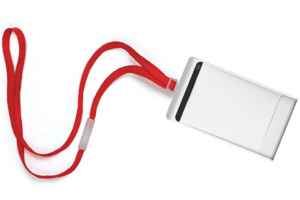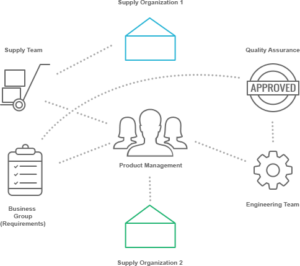Wearables at Work: Is the rise of “people analytics” software innovative or intrusive?

Humanyze is a smart employee badge that helps companies analyze employee interactions to increase operational efficiency. This blog post analyzes the tradeoffs between workers' privacy and gathering data that could improve team outcomes.
The proliferation of fitness trackers and sleep monitors has given rise to the quantified-self movement. Recently, this trend has started to gain traction in corporate environments as well. The number of employers using wearable technology as part of their HR strategies is up 30% since 2014 and 55% of companies are using these devices to boost worker productivity.[1] One of these companies, Humanyze, uses a smart employee badge to evaluate how employees interact with one another. The badge contains a microphone, accelerometer, Bluetooth connection and other tools to measure how people move throughout an office, track who they interact with and even analyze their tone of voice.[2] Humanyze’s back-end software breaks down the important information in real-time into a dashboard showcasing key trends for employers. One of the key challenges in human capital management is that performance evaluations often contain flawed inputs. Managers rely on self-reports or a small sample size of incidents when evaluating how team members interact with one another. [3] Humanyze’s platform allows managers to apply analytic rigor to their observations of team behavior and provides routine un-biased feedback for employees.

Recently, Bank of America used Humanyze to improve customer service in their call centers which employ 10,000 people around the world. Initially, Bank of America and Humanyze set out to study how employees communicated with customers. However, they realized that what actually improved outcomes was how frequently employees spoke with one another to share information and techniques. Humanyze found that employees interacted most during their fifteen-minute overlap in lunch breaks. Bank of America ran a test allowing one group to eat lunch at the same time and kept the other group’s lunch break staggered. Among the experimental group, network cohesiveness went up 18% and stress levels declined 19%. Furthermore, turnover rates went down 28% and call completion time improved by 23%.[4] These important data points around employee interaction helped Bank of America discover a low-cost solution to improving employee engagement.

Privacy Concerns
The rise of employee monitoring devices has caused concern amongst critics who worry that these technologies are too invasive. Humanyze insists that their content, like audio, is not recorded, but instead analyzed in real-time. They also do not give companies access to individual data, they only provide analysis on aggregate data. Only employees can see their own individual metrics. MIT Professor Alex “Sandy” Petland argues that in this new world of big data, allowing people to own their own data should be a prerequisite for all companies offering tracking and monitoring services. In his “New Deal on Data,” he argues that individuals will consent to less privacy if they feel the data will benefit them and will not be shared without their approval.[5]
But when does employee monitoring stop being helpful and start being harmful? Ethan Bernstein argues in “The Transparency Trap” that too much transparency can be counter-productive in organizations because employees may waste time trying to manage impressions. Drawing on the findings from this article, Humanyze can mitigate some of these concerns by helping their partner organizations create “zones of privacy.” They can do this by limiting their observations to well-defined teams (which can increase the level of psychological safety), ensuring their experiments are time-bound and removing judgment from feedback loops. [6]
Future Applications
Going forward, I think one of the most promising applications of Humanyze will be in studying the collective intelligence of teams. Studies have found that a team’s collective intelligence depends not on the intelligence of individual members, but on their social sensitivity, conversational turn-taking and number of women on the team.[7] Humanyze provides an un-biased method for companies to analyze the collective intelligence of different teams within their organizations and track their improvements over time. It could also be a helpful tool for studying implicit bias within organizations around gender, sexuality and race. Using Humanyze’s data, managers can study inter-office networks to see how these biases manifest themselves and develop new solutions. As Humanyze begins to reach scale and amass a more comprehensive dataset, it will be interesting to compare their findings across companies to advance the study of interpersonal networks in corporate environments.
[799 words]
[1] Brin, Dinah W. “Wearable Worries.” HRMagazine, vol. 61, no. 5, 2016., pp. 138-140. http://search.proquest.com.ezp-prod1.hul.harvard.edu/docview/1794444119?accountid=11311.
[2] Miller, Ron. “New Firm Combines Wearables and Data to Improve Decision Making.” TechCrunch, 24 February, 2015, https://techcrunch.com/2015/02/24/new-firm-combines-wearables-and-data-to-improve-decision-making/
[3] Onnela, Jukka-Pekka et al. “Using Sociometers to Quantify Social Interaction Patterns.” Sci. Rep. Scientific Reports, vol. 4, 2014, doi:10.1038/srep05604.
[4] Miller, “New Firm Combines Wearables and Data to Improve Decision Making.”
[5] “With Big Data Comes Big Responsibility.” Harvard Business Review, 5 Nov. 2014, hbr.org/2014/11/with-big-data-comes-big-responsibility.
[6] Bernstein, Ethan. “The Transparency Trap.” Harvard Business Review, 28 Oct. 2014, hbr.org/2014/10/the-transparency-trap.
[7] Williams Woolley, Anita et al. “Evidence for a Collective Intelligence Factor in the Performance of Human Groups.” Science, vol. 330, no. 6004, 29 Oct. 2010, pp. 686–688. doi:10.1126/science.1193147.



Hi Liz, this is a fascinating blog post- I had not heard of this new way of tracking individuals at the workplace. I think Professor Petland’s point that people will feel more comfortable with being tracked if they feel in control over their own data is critical in this type of data collection and tracking. I would really like to know how these data tracking ID cards were introduced at Bank of America and how employees Bank of America reacted to this introduction. I believe that in addition to allowing each individual access to their own data, it is critical that employees understand what the intended outcome is when such trackers are introduced. Having a very specific outcome (e.g., examining how we can improve customer satisfaction in call centers) has a very different flavor that simply using the device in a broad surveillance way that may seem like we live in George Orwell’s world of “1984”. Therefore, I could imagine that using these trackers during a limited time period to answer specific questions may be received more openly by employees than compared to a constant, never-ending use of the tracker.
Awesome post Liz! Like Hannah, I have also not heard of this company or new method of tracking employees. Frankly, I am probably on the end of the spectrum that finds this slightly terrifying. While the company insists that they do not record the employees, I that seems hard to believe. Its like when Snapchat says they don’t keep your pictures- sure guys. There are so many scenarios that come to mind in which the employees actions or words could be used against them. That being said, the possibilities you mentioned in analyzing the performance of teams would be a great application, especially if it could increase diversity in some industries.
Liz, woah fascinating read. Thank you. Like Hannah, I had not yet heard of this technology. As you mentioned, smartwatches and related technologies are greatly increasing our capacity to track and improve our physical lives. Health and happiness benefits can be happy outcome. To me, this Humanyze technology further pushes the frontier on optimization. But, I wonder if or when we as a society will reach an unacceptable optimization threshold? In the near future, will I be measuring (or be measured on!) every activity in my day?! Perhaps….
Great article! I think this technology has a lot of potential. I think the next step for Humanyze will be to go from diagnostic to predictive analytics. What I mean by this, is take the current state of the team and recommend actions they should take to improve future performance. This could be particularly interesting if they could partner with a company like Slack that is starting to manage the communication and scheduling of teams. Humanyze may be able to identify two people on a team should chat and schedule the meeting through Slack or realize a team needs to make a decision and launch a poll on Slack. I think a lot of times managers or teams see this data, but do not really know how to make it actionable (I wonder if you came across this pushback in your analysis?) and this could be a great opportunity for Humanyze to leverage their data and make teams more effective.
Really enjoyed this post, Liz. Like the other commenters, I have concerns that Humanyze’s goal of helping employees interact with each other more effectively and maintaining their privacy are in conflict.
In order for employees to improve interactions with their colleagues, employees need data on what went positively and negatively during interactions. If Humanyze IS NOT storing that data for employee self-review, then I’m not sure how useful the insights the software generates can be. If Humanyze IS storing that data, then I have concerns that the information will be abused by Humanyze or a malicious third party. Given the reputational damage inflicted from email hacking scandals, I can only imagine how much more disastrous a conversation log hack would be for companies using this software.
Thanks for writing a fascinating post, Liz! I see so much potential in what Humanyze is building. For example, we have spent so much time in LEAD discussing organizations that have structured their teams in different ways to accomplish different objectives. For Valve, it was mobile desks to promote creativity; Bridgewater focused on having very flat organizations with transparent communications based on first principles. Humanyze would be an incredible tool to help any of these organizations measure the actual impact any of their initiatives have on helping them accomplish their goals.
I do agree with many of the other commenters, however, that privacy is a big concern. While it makes sense for the employers to adopt such a tool, I have difficulty seeing how they can incentivize employees to embrace it. Is it mandatory for all employees? If not, does it lose its effectiveness if only 50% of employees elect to participate? And does choosing not to participate in such a program lead to employee discrimination?